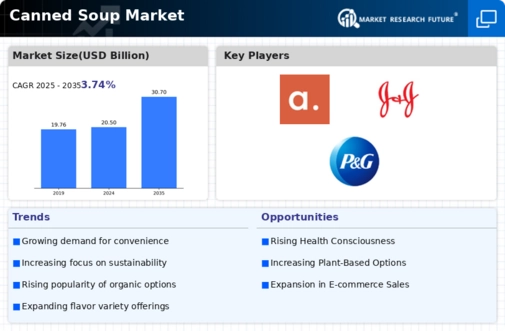Market Growth Projections
The Global Canned Soup Market Industry is projected to experience steady growth, with a compound annual growth rate (CAGR) of 3.74% anticipated from 2025 to 2035. This growth trajectory indicates a robust demand for canned soups, driven by various factors including convenience, health trends, and innovative product offerings. As the market evolves, it is expected to reach a valuation of 30.7 USD Billion by 2035. This upward trend reflects the industry's adaptability to changing consumer preferences and the ongoing efforts of manufacturers to enhance product quality and variety. Such projections underscore the potential for sustained growth in the canned soup sector.
Health and Wellness Trends
The Global Canned Soup Market Industry is influenced by the rising health consciousness among consumers. There is a growing preference for soups that are low in sodium, contain organic ingredients, and are free from preservatives. This shift towards healthier options aligns with broader dietary trends, as individuals become more aware of the nutritional content of their food. Manufacturers are responding by reformulating their products to meet these demands, which may enhance their market appeal. As a result, the industry is likely to see an increase in sales of health-oriented canned soups, contributing to the overall growth of the market.
Innovative Flavors and Varieties
Innovation plays a crucial role in the Global Canned Soup Market Industry, as manufacturers introduce new flavors and varieties to attract diverse consumer preferences. The incorporation of global cuisines and unique ingredients can differentiate products in a competitive landscape. For instance, the introduction of ethnic flavors such as Thai coconut curry or Moroccan spiced lentil soup caters to adventurous eaters seeking novel experiences. This trend not only enhances consumer interest but also drives sales, as unique offerings can capture the attention of a broader audience. The continuous evolution of product lines is likely to support the industry's growth trajectory.
Rising Demand for Convenience Foods
The Global Canned Soup Market Industry experiences a notable increase in demand for convenience foods, driven by the fast-paced lifestyles of consumers. As individuals seek quick meal solutions, canned soups offer a practical option that requires minimal preparation time. This trend is particularly evident in urban areas where busy schedules leave little room for traditional cooking. In 2024, the market is projected to reach 20.5 USD Billion, reflecting the growing preference for ready-to-eat meals. Additionally, the convenience factor is likely to propel the market further, as consumers increasingly prioritize ease of use in their food choices.
E-commerce Growth and Online Availability
The Global Canned Soup Market Industry is witnessing a surge in e-commerce growth, as online shopping becomes a preferred method for consumers. The convenience of purchasing canned soups through digital platforms allows for easy access to a wide range of products. This trend is particularly relevant in the context of changing shopping behaviors, where consumers appreciate the ability to compare options and read reviews before making purchases. As e-commerce continues to expand, it is anticipated that the market will benefit from increased sales through online channels. This shift may contribute to the projected growth of the industry, with expectations of reaching 30.7 USD Billion by 2035.
Sustainability and Eco-Friendly Packaging
Sustainability has become a pivotal concern within the Global Canned Soup Market Industry, as consumers increasingly favor brands that prioritize eco-friendly practices. The shift towards sustainable packaging solutions, such as recyclable materials and reduced plastic usage, resonates with environmentally conscious shoppers. Companies that adopt these practices may enhance their brand image and attract a loyal customer base. Furthermore, as sustainability becomes a key differentiator in the market, it is expected to influence purchasing decisions significantly. This trend could potentially lead to a more substantial market share for brands that align with these values, fostering growth in the industry.













